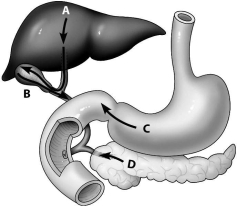A) Meat is more difficult to digest than vegetable matter because of its protein content.
B) We expect that an herbivore will have a longer alimentary canal than a carnivore of similar body size.
C) When cows chew their cud,it helps to soften and break down plant fibers,making these more accessible to digestion by microbes.
D) Many herbivorous animals have cellulose- digesting microbes in their colon and cecum.
F) A) and C)
Correct Answer

verified
A
Correct Answer
verified
Multiple Choice
Most animals are
A) substrate feeders.
B) suspension feeders.
C) fluid feeders.
D) bulk feeders.
F) B) and C)
Correct Answer

verified
Correct Answer
verified
Multiple Choice
Which arrow shows the release of digestive enzymes by the pancreas? 
A) arrow A
B) arrow B
C) arrow C
D) arrow D
F) None of the above
Correct Answer

verified
D
Correct Answer
verified
Multiple Choice
When the wall of the stomach cannot protect the organ from the effects of digestion,the result is
A) nausea.
B) heartburn.
C) reverse peristalsis.
D) a gastric ulcer.
F) A) and C)
Correct Answer

verified
Correct Answer
verified
Multiple Choice
Human saliva performs all of the following functions except
A) hydrolyzing proteins.
B) hydrolyzing starch.
C) controlling bacterial populations.
D) neutralizing food acids.
F) B) and D)
Correct Answer

verified
Correct Answer
verified
Multiple Choice
In the digestive system,most nutrient absorption occurs in the
A) large intestine.
B) stomach.
C) pancreas.
D) small intestine.
F) A) and C)
Correct Answer

verified
Correct Answer
verified
Multiple Choice
The secretory parietal cells of the stomach are responsible for producing
A) pepsin.
B) lactic acid.
C) mucus.
D) hydrochloric acid.
F) C) and D)
Correct Answer

verified
D
Correct Answer
verified
Multiple Choice
The rate of energy consumption by the body is called
A) glycolysis.
B) metabolism.
C) digestion.
D) metabolic rate.
F) A) and C)
Correct Answer

verified
Correct Answer
verified
Multiple Choice
Which of the following diseases is associated with obesity?
A) rheumatoid arthritis
B) cardiovascular disease
C) chicken pox
D) multiple sclerosis
F) A) and B)
Correct Answer

verified
Correct Answer
verified
Multiple Choice
Organisms suffering from malnutrition may have a diet deficient in
A) one or more essential nutrients.
B) digestive enzymes.
C) bile and acids needed for digestion.
D) water.
F) A) and D)
Correct Answer

verified
Correct Answer
verified
Multiple Choice
What is the main digestive function of the pancreas?
A) to produce digestive enzymes and bile salts
B) to produce digestive enzymes and an alkaline solution
C) to aid in the control of cholesterol
D) to produce bicarbonate- containing mucus
F) B) and D)
Correct Answer

verified
Correct Answer
verified
Multiple Choice
Essential fatty acids,which are required in the human diet,are
A) the fatty acids used in the construction of the phospholipids of cell membranes.
B) the fatty acids that humans can synthesize from simpler molecules.
C) those fatty acids that humans are unable to synthesize.
D) stored in the gallbladder.
F) None of the above
Correct Answer

verified
Correct Answer
verified
Multiple Choice
Which of the following statements regarding animals is false?
A) Animals that eat meat are called carnivores.
B) Animals that eat plants are called herbivores.
C) Animals that live in or on their food source and eat their way through it are called substrate feeders.
D) Animals that extract food particles suspended in the surrounding water are called fluid feeders.
F) None of the above
Correct Answer

verified
Correct Answer
verified
Multiple Choice
Absorption of water is a major function of the
A) esophagus.
B) rectum.
C) colon.
D) appendix.
F) C) and D)
Correct Answer

verified
Correct Answer
verified
Multiple Choice
Which of the following statements regarding metabolism is false?
A) Cells usually use carbohydrates and fats as fuel sources.
B) Humans store some extra energy in the form of glycogen reserves in the pancreas and spleen.
C) The basal metabolic rate is the amount of energy an animal needs just to stay alive,and does not include the energy needed for activities.
D) The average basal metabolic rate for humans is 1300- 1800 kcal per day.
F) A) and C)
Correct Answer

verified
Correct Answer
verified
Multiple Choice
Which of the following organisms has a gastrovascular cavity?
A) hydra
B) earthworm
C) bird
D) clam
F) All of the above
Correct Answer

verified
Correct Answer
verified
Multiple Choice
The main function of an earthworm's gizzard is to
A) grind food.
B) store food.
C) moisten food.
D) absorb nutrients.
F) A) and D)
Correct Answer

verified
Correct Answer
verified
Multiple Choice
An animal digestive tract that consists of two openings (a mouth and anus) is called
A) an intestine.
B) a mammalian crop.
C) the alimentary canal.
D) an excretory system.
F) A) and C)
Correct Answer

verified
Correct Answer
verified
Multiple Choice
Which of the following correctly lists the order of the parts of the human digestive system,from first to last contact with food matter?
A) pharynx,oral cavity,esophagus,stomach,large intestine
B) oral cavity,pharynx,esophagus,stomach,small intestine,large intestine
C) oral cavity,esophagus,stomach,large intestine,small intestine
D) esophagus,pharynx,stomach,small intestine,large intestine
F) C) and D)
Correct Answer

verified
Correct Answer
verified
Multiple Choice
During which of the following stages of food processing is undigested material removed from the digestive tract?
A) absorption
B) ingestion
C) elimination
D) digestion
F) B) and D)
Correct Answer

verified
Correct Answer
verified
Showing 1 - 20 of 69
Related Exams